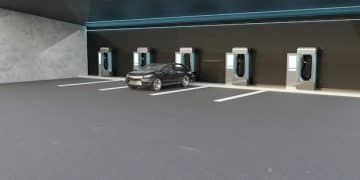Electric Vehicle Policy Update: US Mandates EVs by 2035

The Electric Vehicle Policy Update in the US mandates that all new vehicles sold must be electric by 2035, significantly impacting the automotive industry, consumer choices, and infrastructure development nationwide.
The automotive landscape in the United States is on the cusp of a significant transformation. A landmark Electric Vehicle Policy Update: New Federal Regulations Mandate All New Vehicles Be Electric by 2035 – What You Need to Know may reshape how Americans drive and influence the global automotive market.
Understanding the Electric Vehicle Policy Update
The transition to electric vehicles (EVs) is gathering momentum globally, and the United States is taking a significant step with a new policy update. This policy aims to accelerate the adoption of EVs nationwide by setting a firm deadline for phasing out new gasoline-powered vehicles.
This update isn’t just about reducing emissions; it’s a comprehensive plan to modernize transportation, stimulate economic growth in the EV sector, and enhance energy independence. Let’s delve into the details of this transformative policy.
Key Provisions of the Mandate
The core of the Electric Vehicle Policy Update is the mandate that all new vehicles sold in the US by 2035 must be electric. But what does this actually entail?
- Phased Approach: The transition won’t happen overnight. The policy likely includes a gradual phasing-in period, increasing the percentage of EV sales each year leading up to 2035.
- Incentives and Support: To encourage adoption, the policy likely includes incentives such as tax credits, rebates, and subsidies for EV purchases. Support for building out charging infrastructure is also crucial.
- Performance Standards: The mandate may stipulate minimum performance standards for EVs, ensuring they meet consumer expectations in terms of range, charging speed, and reliability.
This phased approach, coupled with strong incentives and performance benchmarks, aims to create a smooth and effective transition to an all-electric vehicle market.

The Rationale Behind the 2035 Mandate
The decision to mandate EVs by 2035 is driven by several compelling factors, reflecting a growing urgency to address climate change and modernize the transportation sector.
This strategic move is not only about environmental concerns but also has significant economic and social implications that need to be considered.
Environmental Benefits
The most prominent reason for the EV mandate is the significant reduction in greenhouse gas emissions. Transportation is a major contributor to air pollution, and transitioning to EVs offers a cleaner alternative.
- Reduced Carbon Footprint: EVs produce zero tailpipe emissions, reducing the overall carbon footprint of the transportation sector.
- Improved Air Quality: Widespread EV adoption will lead to cleaner air in urban areas, reducing respiratory illnesses and improving public health.
- Sustainable Energy Future: The shift to EVs supports the transition to renewable energy sources, as electricity can be generated from solar, wind, and other clean energy sources.
These environmental benefits are not just theoretical; they represent tangible improvements in air quality and a step towards a more sustainable future.
Impact on the Automotive Industry
The 2035 mandate will have a profound impact on the automotive industry, compelling manufacturers to accelerate their EV development and production plans.
This shift represents both a challenge and an opportunity for automakers, driving innovation and reshaping the competitive landscape.
Manufacturer Adaptation
Automakers will need to invest heavily in research and development, retool their factories, and train their workforce to meet the EV mandate. Here’s how:
Strategic Investments: Significant capital will be required to develop new EV platforms, battery technology, and charging solutions.
Supply Chain Adjustments: Automakers will need to secure reliable supplies of critical materials such as lithium, cobalt, and nickel for battery production.
Workforce Training: The transition to EV production will require retraining workers and hiring new engineers and technicians with expertise in electric vehicle technology.

Consumer Implications and Considerations
For consumers, the EV mandate brings both benefits and challenges. Understanding the implications is crucial for making informed decisions about vehicle purchases.
This transition will change the way people drive and maintain their vehicles, requiring adjustments in habits and expectations.
Cost and Affordability
The initial cost of EVs has been a barrier for many consumers. However, prices are expected to decrease as technology improves and production scales up. Here are some factors to consider:
- Purchase Price: While EVs currently tend to be more expensive than comparable gasoline-powered vehicles, government incentives and tax credits can help offset the cost.
- Operating Costs: EVs have lower operating costs due to cheaper electricity compared to gasoline and reduced maintenance requirements.
- Resale Value: The resale value of EVs is expected to increase as demand grows and technology advances.
While the upfront cost may be higher, the long-term savings and environmental benefits can make EVs a compelling choice for many consumers.
Infrastructure Development and Charging Needs
A successful transition to an all-electric vehicle market hinges on the development of a robust charging infrastructure. Availability and accessibility of charging stations are critical for consumer confidence and convenience.
Without adequate charging infrastructure, the adoption of EVs will be limited, hindering the effectiveness of the 2035 mandate.
Charging Solutions
There are several types of charging solutions that need to be deployed to meet the growing demand for EVs:
Home Charging: Many EV owners will rely on home charging, installing Level 2 chargers for overnight replenishment.
Public Charging Stations: Public charging stations, including Level 2 and DC fast chargers, are essential for long-distance travel and those without home charging options.
Workplace Charging: Employers can offer charging stations as an employee benefit, encouraging EV adoption and providing convenient charging options.
Navigating the Transition: What Consumers Need to Know
As the 2035 mandate approaches, consumers need to be informed and prepared for the shift to electric vehicles. Understanding the policy, available incentives, and the benefits of EVs will help them make the right choices.
This transition is not just about buying a new car; it’s about embracing a new way of thinking about transportation and sustainability.
Steps to Prepare
Here are some steps consumers can take to prepare for the EV transition:
- Research EV Models: Explore the various EV models available, comparing range, features, and price points.
- Assess Charging Needs: Evaluate home charging options and identify nearby public charging stations.
- Explore Incentives: Investigate available tax credits, rebates, and other incentives for EV purchases.
By taking these steps, consumers can navigate the transition to EVs with confidence and contribute to a cleaner, more sustainable future.
| Key Point | Brief Description |
|---|---|
| 🗓️ 2035 Mandate | All new vehicles sold in the US must be electric by 2035. |
| 🌱 Environmental Benefits | Reduced emissions, improved air quality, and a move toward renewable energy. |
| 💰 Consumer Costs | EVs may have higher initial costs but lower operating expenses and potential incentives. |
| ⚡ Infrastructure | Building more home, public, and workplace charging stations is crucial. |
FAQ
▼
The 2035 EV mandate requires that all new vehicles sold in the United States must be electric by the year 2035. This aims to reduce emissions and promote sustainable transportation.
▼
Car manufacturers will need to heavily invest in EV technology, retool their factories, and innovate to meet the growing demand for electric vehicles by 2035.
▼
Electric vehicles offer reduced emissions, lower operating costs, improved air quality, and a quieter driving experience, contributing to a more sustainable environment.
▼
Yes, the cost of electric cars is expected to decrease as technology advances, production scales up, and government incentives become more readily available to consumers.
▼
Expansion of charging infrastructure is crucial. More home, public, and workplace charging stations will be needed to support the growing number of electric vehicles on the road.
Conclusion
The Electric Vehicle Policy Update, mandating all new vehicles to be electric by 2035, signifies a pivotal shift towards sustainable transportation in the United States. While challenges remain in terms of infrastructure and affordability, the environmental and economic benefits are undeniable. By preparing for this transition, consumers and industries can contribute to a cleaner, more sustainable future.





